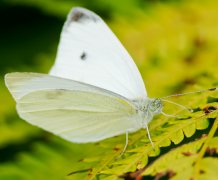articles

Image courtesy of Shutterstock
Butterflies heat up the field of solar research
The humble butterfly could hold the key to unlocking new techniques to make solar energy cheaper and more efficient, pioneering new research has shown.
A team of experts from the University of Exeter has examined new techniques for generating photovoltaic (PV) energy – or ways in which to convert light into power.
They showed that by mimicking the v-shaped posture adopted by Cabbage White butterflies to heat up their flight muscles before take-off, the amount of power produced by solar panels can increase by almost 50 per cent.
Crucially, by replicating this ‘wing-like’ structure, the power-to-weight ratio of the overall solar energy structure is increased 17-fold, making it vastly more efficient.
The research by the team from both the Environment and Sustainability Institute (ESI) and the Centre for Ecology and Conservation, based at the University of Exeter’s Penryn Campus in Cornwall, is published in the leading scientific journal, Scientific Reports.
Professor Tapas Mallick, lead author of the research said: “Biomimicry in engineering is not new. However, this truly multidisciplinary research shows pathways to develop low cost solar power that have not been done before.”
The Cabbage White butterflies are known to take flight before other butterflies on cloudy days – which limit how quickly the insects can use the energy from the sun to heat their flight muscles.
This ability is thought to be due to the v-shaped posturing, known as reflectance basking, they adopt on such days to maximise the concentration of solar energy onto their thorax, which allows for flight.
Furthermore, specific sub-structures of the butterflies’ wings allow the light from the sun to be reflected most efficiently, ensuring that the flight muscles are warmed to an optimal temperature as quickly as possible.
The team of scientists therefore investigated how to replicate the wings to develop a new, lightweight reflective material that could be used in solar energy production.
The team found that the optimal angle by which the butterfly should hold its wings to increase temperature to its body was around 17 degrees, which increased the temperature by 7.3 degrees Centigrade compared to when held flat.
They also showed that by replicating the simple mono-layer of scale cells found in the butterfly wings in solar energy producers, the could vastly improve the power-to-weight rations of future solar concentrators, making them significantly lighter and so more efficient.
Professor Richard ffrench-Constant, who conducts world-leading research into butterfly mimicry at the University of Exeter, said: “This proves that the lowly Cabbage White is not just a pest of your cabbages but actually an insect that is an expert at harvesting solar energy.”
The paper, White butterflies as solar photovoltaic concentrators, by Katie Shanks, Dr Senthilarasu Sundaram, Professor Richard ffrench-Constant and Professor Tapas Mallick from the University of Exeter, is available online.
Date: 31 July 2015
